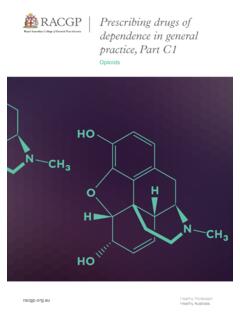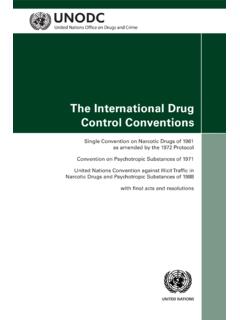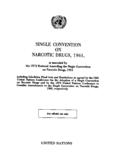Transcription of Afghanistan Opium Survey 2020
1 APRIL 2021 Afghanistan Opium Survey 2020 Cultivation and Production Executive SummaryResearchIslamic Republic of Afghanistan Page intentionally left blank Afghanistan Opium Survey 2020 Executive Summary 3 Introduction This Executive Summary presents the key findings of the Afghanistan Opium Survey 2020. The Survey is implemented by NSIA in collaboration with UNODC. The Survey team collects and analyses information on the location and extent of Opium poppy cultivation, potential Opium production and the socio-economic situation in rural areas.
2 This information is essential for planning, implementing and monitoring counter-narcotic efforts. The Opium Survey is implemented within the technical framework of the UNODC Illicit Crop Monitoring Programme (ICMP), established in 1999 upon request of the Commission on Narcotic Drugs in its resolution 42/3, Monitoring and verification of illicit cultivation. The objective of ICMP is to assist the international community in monitoring the extent and evolution of illicit crops and to compile reliable and internationally comparable data. Currently, UNODC carries out monitoring activities in seven countries affected by illicit crop cultivation: coca surveys in Bolivia, Colombia and Peru; Opium poppy surveys in Afghanistan , Mexico and Myanmar; and a cannabis Survey in Nigeria.
3 The Afghanistan Opium Survey 2020 was implemented under the project Monitoring of Opium Production in Afghanistan (AFG/F98), with financial contributions from the Government of United States of Opium Survey 2020 Executive Summary 4 Fact Sheet, Afghanistan Opium Survey 20201 2019 Change from 2019 2020 Opium poppy cultivation2 163,000 ha (149,000 - 178,000) 37% 224,000 ha (202,000 - 246,000) Number of poppy free provinces3 13 out of 34 -1 12 out of 34 Number of provinces affected by poppy cultivation 21 out of 34 +1 22 out of 34 Eradication4 21 ha NA NA Average Opium yield (weighted by cultivation)5 NA NA kg/ha Potential production of opium5 NA NA 6,300 tons (5,400 -7,200) Average farm-gate price of fresh Opium at harvest time US$ 52/kg -18% US$ 42/kg Average farm-gate price of dry Opium at harvest time US$ 63/kg -13% US$ 55/kg Total farm gate value of Opium production NA NA US$ 350 (300 400) million Note.
4 Estimates are rounded, percentage changes have been calculated based on precise figures. 1 Numbers in brackets indicate the lower and upper bounds of the 95% confidence interval. 2 In 2019, eradicated area was accounted for in the area estimates. In 2020, no verified eradication data was available to NSIA/UNODC. 3 A province is defined as poppy -free when it is estimated to have less than 100 hectares of Opium poppy cultivation. 4 In 2020, Opium poppy eradication could not be verified by NSIA/UNODC. 5 Data on Opium yield and production for 2019 were not validated by the Government of Afghanistan and have not been published in a joint NSIA/UNODC report.
5 Afghanistan Opium Survey 2020 Executive Summary 5 The area under Opium poppy cultivation increased by 37% in 2020 The total area under Opium poppy cultivation in Afghanistan was estimated at 224,000 hectares (202,000 - 246,000) in 2020, which represents an increase of 37% or 61,000 hectares when compared to 2019. Figure 1 Opium poppy cultivation in Afghanistan , 1994-2020 (hectares) Sources: MCN/UNODC Opium surveys 1994-2018 ; NSIA/UNODC Opium surveys 2019 onwards. The vertical lines represent the upper and lower bounds of the 95% confidence interval. All regions6 except the Eastern region saw an increase in Opium poppy cultivation in 2020, with the largest relative increases being in the Southern region, followed by the Western, North-eastern, Northern, Central and South-Western regions.
6 Cultivation in the Eastern region reduced by 28%. In 2020, the number of poppy -free provinces in Afghanistan decreased from 13 to 12. Kapisa lost its poppy -free status. Hilmand remained the country s major Opium poppy cultivating province, followed by Badghis, Kandahar, Uruzgan7, Faryab, Farah, Badakhshan, Balkh and Nimroz. All main Opium poppy -growing provinces saw significant increases in area under cultivation. Opium poppy cultivation increased in Badghis (194%), in Faryab (98%), Kandahar and Farah (47%), Nimroz (46%), Badakhshan (36%), Hilmand (27%) and Uruzgan (16%).
7 Decreases were observed in four provinces with lower levels of cultivation, in Kunar (-39%), Nangarhar (-27%), Laghman (-20%), Balkh and Jawzjan provinces (-16%). In absolute numbers, the largest increases were observed in Hilmand (24,870 ha), Badghis (14,771), Kandahar (6,600 ha) and Faryab (6,462) and the largest decrease in Balkh (1,096 ha). Table 4, at the end of this report, presents an overview of all provincial estimates. 6 The regional groupings used in this report are in line with the groupings used in the work of NSIA and are different from those used in earlier reports. See Map 2. 7 Including Gizab district, a district formally part of Day Kundi province, but since 2014 under the administration of the Governor of Uruzgan province.
8 Afghanistan Opium Survey 2020 Executive Summary 6 Table 1. Regional distribution of Opium poppy cultivation, 2019-2020 (hectares) Region 2019 (ha) 2020 (ha) Change 2019-2020 2019 (ha) as % of total 2020 (ha) as % of total Central 780 1,011 30% 0% Eastern 4,942 3,543 -28% 3% 2% North-eastern 4,973 6,967 40% 3% 3% Northern 17,128 22,760 33% 11% 10% South-western 118,444 152,935 29% 73% 68% Southern 123 290 136% Western 17,053 36,188 112% 10% 16% Rounded Total 163,000 224,000 37% 100% 100% Eradication of Opium poppy in 2020 In 2020, Opium poppy eradication could not be verified by NSIA/UNODC.
9 Potential Opium production was estimated at 6,300 tons in 2020 In 2020, potential Opium production in Afghanistan was estimated at 6,300 tons (5,400 - 7,200 tons). The average Opium yield was kilograms per hectare. The South-western region remained the country s major Opium producing region, accounting for 71% of total Opium production in Afghanistan . In 2020, due to COVID-19 related measures, it was not possible for NSIA/UNODC to collect Opium yield data in the field. In the absence of the field Survey , UNODC and NSIA jointly estimated Opium poppy yields using satellite imagery. In this approach, a representative sample of Opium poppy fields was visually ranked according to the quality of crops on the field.
10 Each value of the rank (low, medium, and high quality) corresponded to a specific range of yields, which was estimated from previous years yield data per region. For example, previous years data indicated that poppy fields visually ranked as low quality had yield values between 9 and 12 kg/ha in the Central region. Therefore, Opium poppy fields interpreted as low quality in the Central region were assigned those yield values. The procedure was repeated for all rank values, and then average yields were calculated per region, and a weighted average was estimated at national level.


















